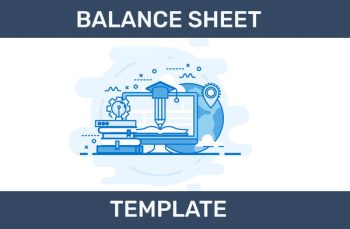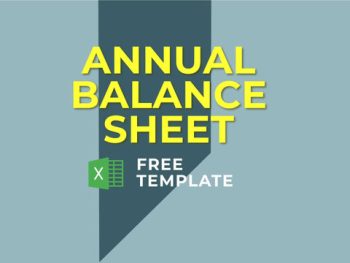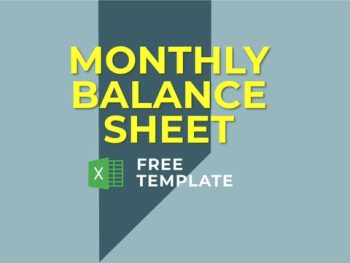- The Benefits of Incremental Budgeting in Business
- Understanding and Implementing Bottom-Up Budgeting
- Financial Modeling and Financial Planning: An Overview
- A Comprehensive Guide to Cash Flow Analysis
- Understand the Benefits of Activity Based Budgeting
After reading this article, you should be Apple to learn:
- What is the balance sheet
- Commonly Head of Balance Sheet Accounts
- Importance of the balance sheet
- FREQUENTLY ASKED QUESTIONS
What is the balance sheet
Balance Sheet also known as Statement of Financial Condition, is one of the five financial statements and it informs users of the financial condition of a business as of a specific date. The balance sheet gives information about the balances of assets, liabilities and equity of a company and these balances are carried for the next year. In layman’s terms, the balance sheet is what a company owns and owes.
A typical balance sheet format is shown below:
|
Restaurant ABC |
||
|
Balance sheet |
||
|
As of June 30, 2021 |
||
|
Amount in “000” |
||
|
Description |
2021 |
2020 |
|
ASSETS |
||
|
Current assets |
||
|
– Bank |
500.00 |
450.00 |
|
– Species |
20.00 |
17.00 |
|
– Inventories |
2,500.00 |
2,000.00 |
|
– Accounts Receivable |
1,500.00 |
1,125.00 |
|
4,520.00 |
3,592.00 |
|
|
Non-current assets |
||
|
– Equipment owned by the factory |
3,000.00 |
2,800.00 |
|
– Capital work in progress |
1,500.00 |
800.00 |
|
– Intangible assets |
300.00 |
320.00 |
|
4,800.00 |
3,920.00 |
|
|
total assets |
9,320.00 |
7,512.00 |
|
Share capital and liabilities |
||
|
EQUITY |
||
|
– Shares the capital |
3,500.00 |
3,500.00 |
|
– Retained earnings |
350.00 |
325.00 |
|
3,850.00 |
3,825.00 |
|
|
Current liabilities |
||
|
– Accounts payable |
2,000.00 |
1,440.00 |
|
– Increased expenses |
1,220.00 |
494.00 |
|
3,220.00 |
1,934.00 |
|
|
Non-current liabilities |
||
|
– Long-term debt |
1,800.00 |
1,350.00 |
|
– refundable to customers |
450.00 |
403.00 |
|
2,250.00 |
1,753.00 |
|
|
Total Equity and Liabilities |
9,320.00 |
7,512.00 |
IMPORTANT NOTE: We have designed free Monthly Balance Sheet & Yearly Balance Sheet where you just need to put your numbers in the yellow cells and see the nicely balanced balance sheet with nice visual information.
Commonly Head of Balance Sheet Accounts
To better understand the income statement, the reader should be familiar with the following general accounting terminologies. Let’s explain in easy words with examples.
Current Assets Current business assets are expected to be sold or used by businesses within one year from the date of purchase. These assets are used to fund the operations of the business. Some current assets are in liquid form such as cash, bank, etc., while others need time to convert to liquid form, such as inventory, accounts receivable, etc.
Non-current assets are the long term assets of a business having a life of more than one year. These assets cannot be easily converted into cash, but these assets contribute to business activities. Non-current assets include fixed assets such as property, plant, equipment, vehicles, etc. which are depreciated over the useful life of assets and other assets such as long-term investments, capital labor progress, etc. The accounting treatment of different assets is different and accounting standards give guidance on the correct accounting treatment (as IAS-16 gives guidance on fixed assets, IAS-38 guides on intangible assets, etc.).
Equity is basically what a business owner owns, and it is also referred to as a business’ net assets (assets minus liabilities). The higher the equity, but the business is high, but it also depends on the life cycle of a business.
Equity basically has two parts:
- Share capital is one of the components of equity and it is the money that business owners have initially contributed to the business. It remains unchanged unless the owners have injected more money into the business. Some companies are listed on a stock exchange called Public Companies and any money raised through the sale of shares (business ownership is divided into units called shares) is the share capital of a company. People who buy stocks get dividends against their investment.
- Retained earnings is also part of equity, and it is the value that the company has remained after paying the dividend to shareholders. In other words, retained earnings are excess earnings and represent reserve money, which is available for business owners to reinvest in the business.
Current liabilities are the short term financial obligations of a company and the company must settle these obligations within one year. Normally, when the business makes money from current assets, that money is used to pay current liabilities. Current liabilities include accounts payable, accrued expenses or any other short-term obligation such as bank overdraft, dividend payable, etc.
Non-current liabilities are long-term obligations of a business that must be settled after one year. Normally, companies enter into long-term liabilities to finance their capital investments. It includes a bank loan payable after one year, long-term rental obligations, etc.
The nature of each of the above components is summarized below:
|
Account Manager |
Increase |
Decrease |
|
Current assets |
Debit |
Credit |
|
Non-current assets |
Debit |
Credit |
|
Equity |
Credit |
Debit |
|
Current liabilities |
Credit |
Debit |
|
Non-current liabilities |
Credit |
Debit |
TIP: There is no generality in classifying an asset as a current asset or a non-current asset and it depends on the nature of the business. Suppose in our restaurant business, the business owner has motorcycles for delivery, and these assets are non-current assets included in property, plant, and equipment. However, in the case of Yamaha-made motorcycles, these must be included in current assets as inventory.
IMPORTANT NOTE: Check out our free specially designed Monthly Balance Sheet and Annual Balance Sheet that helps you prepare the balance sheet by simply entering the numbers in the yellow highlighted cells.
Download the annual balance sheet in Excel
Download the monthly balance sheet in Excel
Importance of the balance sheet
A company’s balance sheet tells stakeholders the health of companies on a specific date. Business owners or other stakeholders study the balance sheet to assess the position of liquidity, business performance, and corporate liabilities. The balance sheet is one of the most important components of financial models as well as other financial statements.
IMPORTANT NOTE: We have designed 450+ Financial Model Templates For different companies which are ready to use and you just need to type the inputs in the yellow cells and you will get the desired financial model.
Business owners calculate liquidity ratios, leverage ratios, efficiency ratios, profitability ratios and market value ratios to compare it with industry leaders, competitors and previous periods for make judgments about the financial situation. However, it is important to note that the financial performance cannot be assessed by the balance sheet in isolation, but the stakeholders also read and evaluate the income and cash flow statement to make the required decision.
FREQUENTLY ASKED QUESTIONS
Q. What is the difference between Income Statement & Balance Sheet?
A. The income statement shows activities during a specific period related to income, expenses, gross profit and net profit, while the balance sheet shows the total value of assets, equity and liabilities at a specific date. Normally, the income statement is used to check the financial/operational performance while the balance sheet is used to assess the financial condition.
Q. What is the difference between the balance sheet prepared on an accrual basis and on a cash basis?
A. The balance sheet prepared in accordance with the basis of accounting has accountants and receivables, while there are no accountants or receivables on the balance sheet prepared in accordance with the basis of accounting. The rest of the balance sheet is similar in both approaches. However, in today’s world, more and more companies are going to the basis of the basis because the cash basis of accounting does not give a true picture of the financial performance and position of a business.
Q. Which income statement figures go to the balance sheet?
A. The addition of net profits and other gains/losses resulting from foreign currency fluctuations, changes in the market value of investments, etc. income statement. This full figure is included in equity on the balance sheet. In case there are no foreign exchange gains/losses or investment market changes, etc., only the net profit is included in balance sheet equity.
[right_ad_blog]





